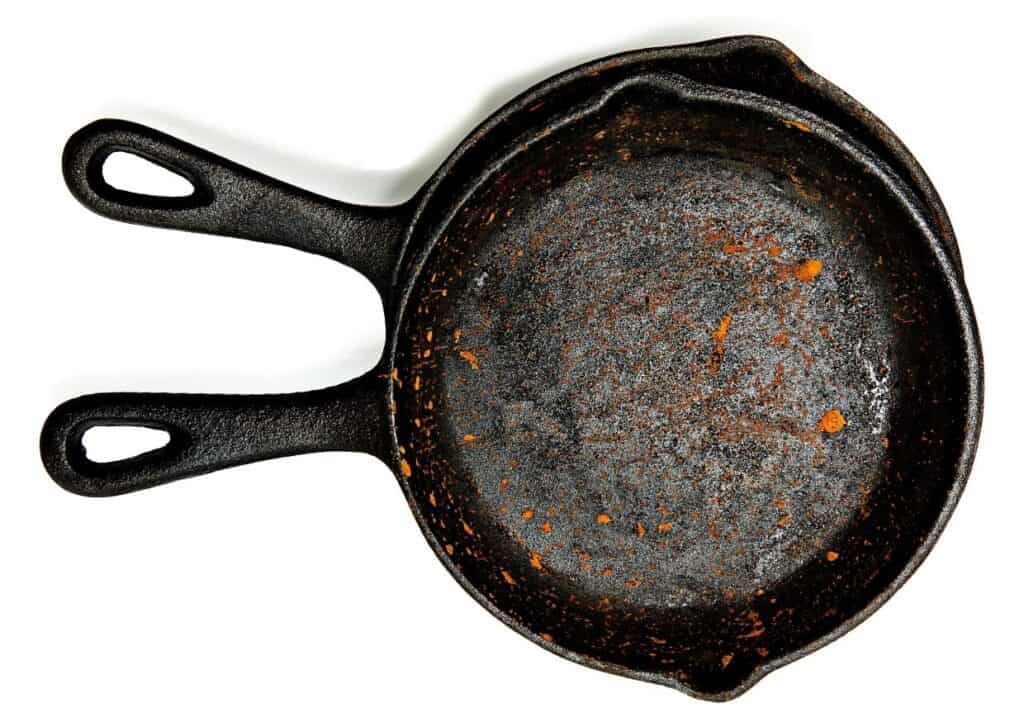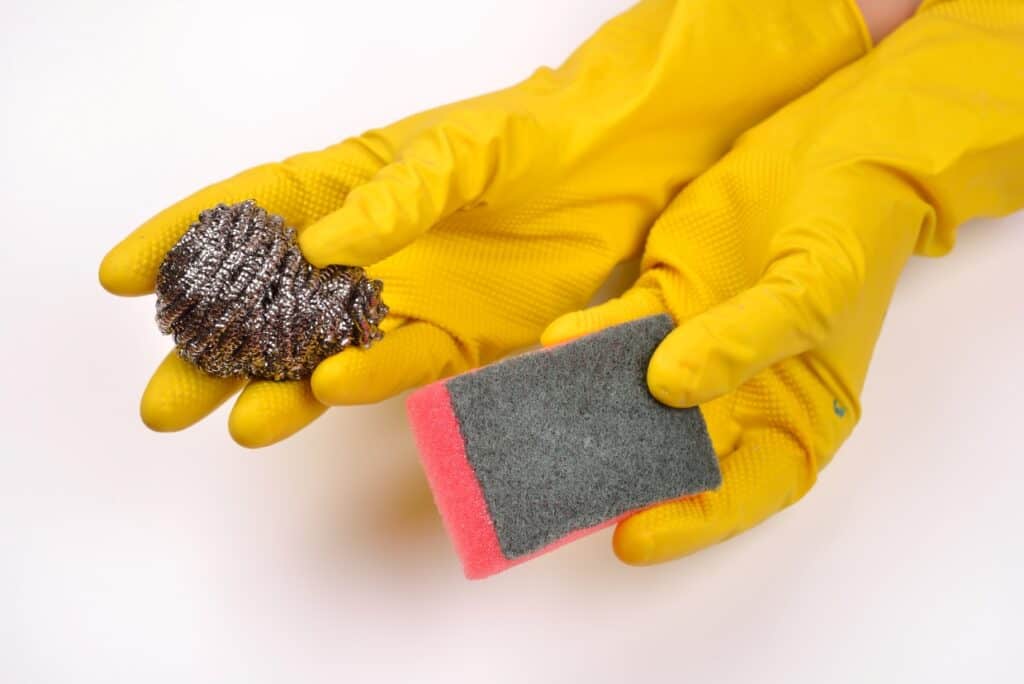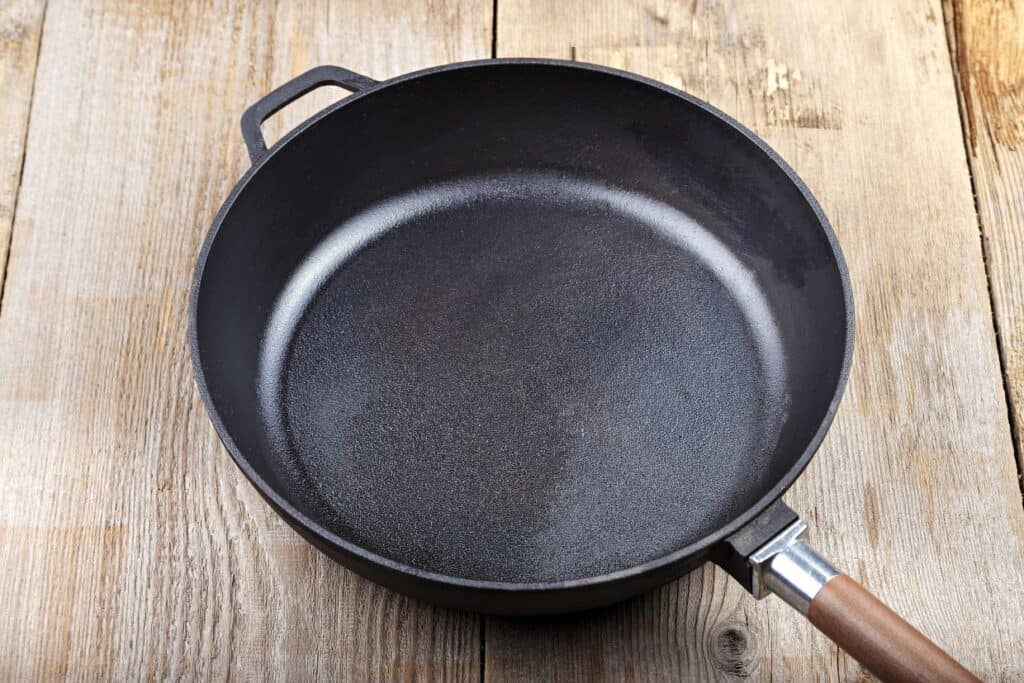Learning how to clean rust from cast iron cookware is key to maintaining its longevity and performance. Cast iron, while durable, is susceptible to rust if not cared for properly. However, rest assured that rust is not the end of the line for your cookware because, with the right approach, you can remove it and restore your cast iron to top condition.

The process of removing rust from cast iron cookware involves a blend of hands-on scrubbing with tools like steel wool and the application of chemical solutions, such as vinegar. It all begins with a careful examination of the rust and collecting everything you’ll need for the job.
After dealing with the rust, it’s very important to rinse and dry your cookware completely to avoid rust forming again. Re-seasoning your pan is the final touch, refreshing its non-stick qualities and safeguarding it against future rust, ensuring it’s ready for your next cooking session.
Pre-cleaning procedure
Before attempting to remove rust from cast iron cookware, prepare the cookware and cleaning area to ensure a safe and efficient process. The following steps outline the pre-cleaning procedure:
Initial cookware assessment: Take a moment to examine the cast iron piece thoroughly. You’ll need to locate all areas affected by rust and determine the extent of rust coverage. Understanding whether you’re dealing with minor surface or more severe pitted rust will help you gauge the effort required.
Cookware preparation: If the cast iron has any food residue or grease, wash it off using warm, soapy water and a brush. After washing, make sure to rinse the cookware thoroughly and dry it immediately with paper towels.
Cleaning agent alert: Be mindful when using vinegar, as its acidic nature can damage cast iron if left in contact for too long. It’s recommended to use it cautiously and keep a close watch on the cookware throughout the rust removal process to avoid any damage.
Mechanical rust removal techniques
You can effectively remove rust from cast iron cookware through mechanical methods. These techniques involve physical actions and tools to scrape or rub the rust away.
Scrubbing with abrasives: Steel wool or sandpaper are effective options when removing rust with abrasives. It’s best to start with a coarse grade and then switch to a finer one to ensure the cookware’s surface isn’t damaged. The process involves vigorously rubbing the rusted areas and then wiping the surface down with a dry cloth to remove any rust particles.

Using the salt and potato method: An unexpectedly effective method involves a potato and coarse kosher salt. To use this technique, sprinkle salt over the rusted area of the cookware. Then, cut a potato in half and scrub the salt into the rust using the cut side. After scrubbing, rinse the cookware with water and then dry it well.
Using a wire brush: For more stubborn rust, a wire brush, especially one attached to a drill for added efficiency, can be very effective. To do this, first, secure the cast iron cookware to prevent it from moving. Then, using steady pressure, apply the wire brush to the rusted areas. After removing the rust, clean the area with a dry cloth to remove all rust particles.
Chemical rust removal methods
You can also effectively treat and restore cast iron cookware with chemical rust removal methods. These approaches use chemical reactions to lift and dissolve the rust, making removal easier.
Utilizing a vinegar soak: Vinegar, thanks to its mild acidity, can effectively dissolve rust. For this method, you’ll want to mix equal parts of white vinegar and water.
Fully submerge your cast iron cookware in the prepared solution for up to 24 hours, but remember to check on it periodically. It’s important to note that leaving cast iron in the vinegar solution for too long can damage it.
After the soak, grab a non-metallic brush and scrub away any remaining rust. Make sure to rinse the cookware thoroughly afterward and dry it immediately.
Applying rust removers: Commercial rust removers offer a concentrated solution to rust issues. Choose a rust remover designed specifically for your needs and follow the manufacturer’s instructions. Be sure to wear gloves and work in a well-ventilated area when using chemical rust removers.
Rinsing and drying the cookware
After you’ve tackled how to clean rust from cast iron cookware, rinsing is your next move. Stick to warm water for the rinse, and use a soft sponge or cloth to gently clean the surface. Drying is as important as the rust removal because cast iron and moisture don’t mix. Forget letting it air-dry; that’s just asking for rust to come back. Instead, pop it on the stove over low heat to zap any lingering moisture, then give it a thorough wipe-down with a clean, dry cloth, getting every spot, handle and edge.
Once the cookware is bone dry, you can season the cast iron by lightly coating it with oil or shortening using a cloth or paper towel. Rub off any excess oil to avoid a sticky finish. Next, crank your oven to a temperature between 450 and 500 F, and bake your cookware upside down to prevent pooling while using foil on the bottom rack to catch drips. Once the hour’s up, turn off the oven and let the cookware cool down inside. Repeat this process a couple of times for an extra robust seasoning layer before cooking something like these lemon garlic scallops for dinner tonight.
“If you take care of your cast iron pan properly, it can live forever. It’s critical to ensure that you dry it thoroughly after you wash it because any remaining water will cause it to rust. Once it’s fully dry, rub on a light layer of oil. This will protect it and ensure that your skillet never develops rust.”
— Michelle Price, Honest and Truly
Preventative measures for future rust
To prevent rust and ensure the longevity of your cast iron cookware, a proactive approach is key. Start with proper storage by keeping your cookware in a dry environment and using a paper towel to absorb any leftover moisture.

Routine maintenance is also crucial. After cleaning, apply a thin layer of oil to maintain the seasoning, and dry the cookware thoroughly, preferably by heating it on the stove to remove any moisture.
Lastly, avoid common mistakes like soaking the cookware in water or using harsh detergents and metal scouring pads, which can damage the seasoning and promote rust.
Final thoughts
With all of these things in mind, you can restore your cast iron cookware to its original non-stick surface. Soon it’ll be ready to make your favorite skillet dinners like creamy Tuscan chicken and creamy sun dried tomato chicken.
Sara Nelson is the food blogger behind Real Balanced, a site that showcases easy and balanced recipes. Since 2017, she has shared delicious and nutritious recipes with thousands of blog readers and social media followers. Sara lives in Wisconsin with her husband, two children and their dog.